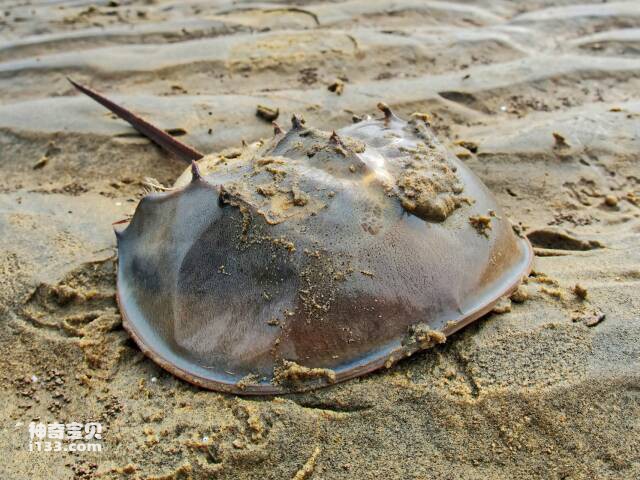Look at this strange animal, it looks like a scoop. Do you know what kind of animal it is? Let me tell you! It is the famous horseshoe crab!
The horseshoe crab is an animal that once lived in the same era as the dinosaurs. However, the huge dinosaurs did not escape the catastrophe at the end of the Cretaceous period and all became extinct. However, this strange-looking animal survived the vicissitudes of the earth. According to fossil data research, they have survived on the earth for such a long time, but their body structure has not changed much, so they are called "living fossils." In addition, judging from the development process of horseshoe crabs, its larvae are very similar to the trilobites that flourished in the ocean hundreds of millions of years ago. Therefore, it can be inferred that horseshoe crabs and trilobites are very closely related. It is very likely that horseshoe crabs are Descendants of trilobites.

The Chinese horseshoe crab is the largest of the living horseshoe crabs. Known as a "living fossil". The body length (including tail sword) can reach 500 mm. It consists of 3 parts: cephalothorax, abdomen and tail sword. The body is covered with hard armor, the cephalothorax carapace is horseshoe-shaped, the abdominal carapace is slightly hexagonal, and there are three spine-like protrusions at the end, also known as the three-spined horseshoe crab. There are 6 pairs of movable barbs on both sides of the male horseshoe crab, while only 3 pairs of barbs are prominent in the female horseshoe crab. The tail sword is triangular pyramidal in shape, and its length is roughly equal to the back armor. Blood contains copper ions, which turn blue when exposed to air.
The horseshoe crab is a kind of arthropod in the ocean. The largest one is 60 centimeters long. They generally live in the sand on the seabed and mainly eat worms and shellless molluscs. From the outside, the horseshoe crab's entire body is like a gourd, all brown and gray, except for a long, sword-like tail, which is nothing special. In fact, if you look closely, the body of the horseshoe crab can be divided into three parts: the cephalothorax, abdomen and sword tail. There are 6 pairs of legs on the cephalothorax, of which the last 5 pairs surround the mouth. When it eats, these 5 pairs of legs act like "teeth" to help it chew food. Therefore, they are classified into the phylum Arthropoda and the class Limostome. The horseshoe crab has a hard plastron and abdominal feet on its abdomen, so that it can not only crawl on the sand with its thoracic feet, but also swim freely in the water with its abdominal feet and burrow into the sand with the help of its sword tail. . Its long sword tail is not only a useful tool, but also a useful weapon for defending against enemies. The hard sword tail is like a sword. It can pierce the enemy's body and give the enemy a heavy blow that will kill him.

There are currently 5 species of horseshoe crabs, the most common of which is the Chinese horseshoe crab. In summer, whether on the beach or at the bottom of the sea, horseshoe crabs can often be seen living together, one large and one small. In fact, when the male horseshoe crab matures, a pair of small curved hooks will grow from the end of the second pair of legs on the cephalothorax. It uses these small hooks to "hug" the female horseshoe crab firmly and lie on her body. . From then on, the two of them lived together, loving each other for the rest of their lives. Therefore, people gave them a nice name - "undersea mandarin ducks". But the fat wife always has to live with this thin husband behind her back, which makes her a little frustrated.
The special thing about the horseshoe crab is not only the above-mentioned things, but the most noteworthy thing is that its blood is blue! As we all know, the blood of us humans and most animals is red. This is because our blood contains Iron ions, when iron ions combine with oxygen, form hemoglobin, making blood red. The blood of horseshoe crabs contains copper ions. When copper ions combine with oxygen, hemocyanin is formed, making the blood blue. Moreover, this blue blood will coagulate once it comes into contact with bacteria. This kind of blood is used in medicine to immediately check whether a patient has a bacterial infection and make a quick diagnosis for the diagnosis and treatment of emergency patients.
This is the peculiar blue-blooded living fossil. If you have a chance, come to the museum to appreciate its elegance!
animal tags:
We created this article in conjunction with AI technology, then made sure it was fact-checked and edited by a Animals Top editor.